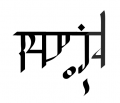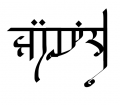Hirgunya
Hirgunya is the common name for the ancient writing system used in late Kalaman Civilization that is the source of many modern writing systems. Hirgunya is an abugida. It is written from left to right. Hirgunya is the parent writing system for several other writing systems, including the Early Ithatian Syllabary, the Midretassene Alphabet, and the Erechórebese Alphabet. A late form of the Classical Hirgunya Abugida Script is still used today to write Shardanian and Jaithan.
You can download the current ttf font [here] and the eot font [here].
- Hirgunya
Hirgunya Script
The Hirgunya Abugida represents syllabic utterances. Special forms indicate the final character of a word. A syllable in Hirgunya can potentially consist of the following components in the following order:
Prefictive S + Connecting Consonant + Stem + vowel or mute + diacritics (if any) + closure
Most syllables in the Shardanian and Jaithan languages do not have all these components, but it is possible. In the word 'sklancha,' the first syllable 'sklan' has all five components, a prefictive s, a connecting consonant 'k,' a stem (liquid) 'l,' a diacritic (short, accented), and a closure 'N.' The 'cha' part of the word is the second and last syllable of the word 'sklancha.'
The Hirgunya Script also has a character for the foreign sound 'll,' a voiceless lateral fricative which does not occur in Jathya-Dhumi languages. It was used to represent this foreign sound found in the Neptultchi Language and the Colnorian Language.
Hirgunya Abugida Table
If the Hirgunya font is not installed, you will see squares instead of the abugida characters (glyphs).
| HIRGUNYA GLYPH | IPA | Transliteration | Keyboard Input | Unicodes |
|---|---|---|---|---|
| | /p/ | p | p | |
| | /b/ | b | b | |
| | /pʰ/, /f/ | ph | f | |
| | /bʰ/, /v/ | bh | v | |
| | /m/ | m | m | |
| | /tʰ/, /θ/ | th | q | |
| | /dʰ/, /ð/ | dh | RA + q | |
| | /t/ | t | t | |
| | /d/ | d | d | |
| | /s/ | s | s | |
| | /z/ | z | z | |
| | /ɬ/ | ll, xh, x̧ | x | used for foreign sounds |
| | /n/ | n | n | |
| | /ʧ/ | ç, ch | c | |
| | /ʤ/ | j | j | |
| | /ʧʰ/ | çh, cch | RA + c | |
| | /ʤʰ/ | jh | RA + j | |
| | /ʃ/ | ş, sh | RA + s | |
| | /ʒ/ | z̧, zh | RA + z | |
| | /ɲ/ | ñ, ny | RA + n | |
| | /k/ | k | k | |
| | /g/ | g | g | |
| | /kʰ/, /x/ | kh | RA + k | |
| | /gʰ/, /ɣ/ | gh | RA + g | |
| | /ŋ/ | ǵ, ng | ||
| | /kʃ/ | k + sh (ligature) | ||
| | /pʃ/ | p + sh (ligature) | ||
| | /nj/ | n + y (ligature) | ||
| | /lw/ | l+w (ligature) | ||
| | /lj/ | l + y (ligature) | ||
| | /gj/ | g + y (ligature) | ||
| | /ghj/ | gh + y (ligature) | ||
| | /s/ | prefictive s | ||
| | /w/ | w (stem) | ||
| | /y/ | y | ||
| | /r/ | r | ||
| , | /l/ | l | ||
| | /ʔ/ | a | ||
| , | /h/ | h | ||
| | /hw/ | hw | ||
| | high mark | |||
| | /N/, /n/, /m/, /ŋ/ | closure nasal | ||
| | /r/ | closure r | ||
| | /l/ | closure l | ||
| | /h/ | closure h | ||
| | null final | |||
| | /ʔ/, / / | syllable begins with ' (usu. foreign) or vowel | ||
| /a/, /ɑ/ | default vocalic value of consonants + stem | |||
| | /ɪ/, /i/ | i | i | |
| , | /ʊ/, /u/ | u | u | |
| | /ɛ/, /e/ | e | e | |
| | /ɔ/, /o/ | o | o | |
| | /ə/ | RA + e | ||
| | /aɪ/ | ai | ||
| | /aʊ/ | au | ||
| | /ɛɪ/ | ei | ||
| | muted consonant | |||
| unmarked, unaccented, not geminate | ||||
| | unaccented, long | |||
| | accented, short | |||
| | accented, long | |||
| | geminate, unaccented, short | |||
| | geminate, unaccented, long | |||
| | geminate, accented, short | |||
| | geminate, accented, long |
Hirgunya Script Renderings
Aarothkopshaz, the planet Orion Pharaonicus
Bhimala, the god Vimal and the lake Vimala
Bhimaloksha, ancient Vimaluna
bimbhari, a native tree of Corundy
See Also
| This article is a stub. It requires further development by the creator. |



















